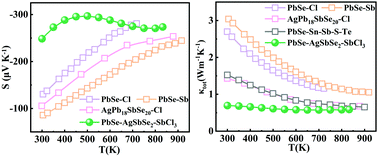Unusually high Seebeck coefficient arising from temperature-dependent carrier concentration in PbSe–AgSbSe2 alloys†
Abstract
The Seebeck coefficient describes the temperature gradient-induced voltage in thermoelectrics. Usually, obtaining a high Seebeck coefficient within a wide temperature range is difficult as it is limited by the Goldsmid-Sharp relationship. In this work, the thermoelectric performance of the PbSe–AgSbSe2 alloy is optimized by SbCl3 doping. Interestingly, the observed Seebeck coefficient hardly varies as temperature increases from 300 K to 830 K, and its absolute value is at a high level of more than 250 μV K−1. By measuring the Hall effect, the anomalous Seebeck coefficient is attributed to the strongly temperature-dependent carrier concentration, which increases from 0.38 × 1019 cm−3 at 300 K to 3.91 × 1019 cm−3 at 830 K. Besides the high Seebeck coefficient, the alloyed compounds exhibit very low thermal conductivity, down to 0.59 W m−1 K−1 at 830 K. Finally, the peak ZT reaches 1.12 at 830 K. It is predicted that the performance of the alloys could be further improved by enhancing the carrier concentration.

- This article is part of the themed collection: Journal of Materials Chemistry C HOT Papers


 Please wait while we load your content...
Please wait while we load your content...